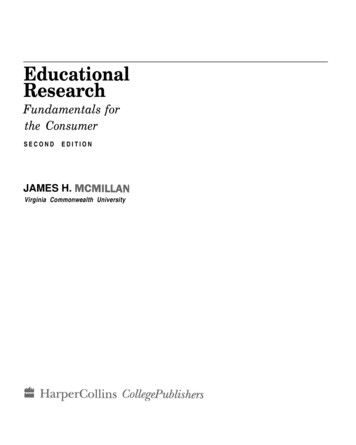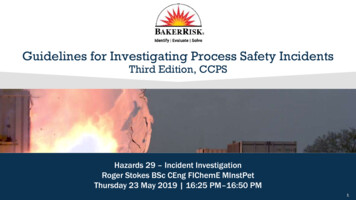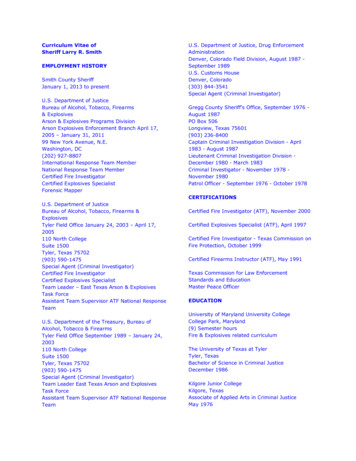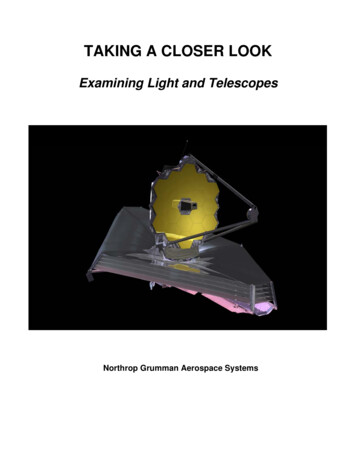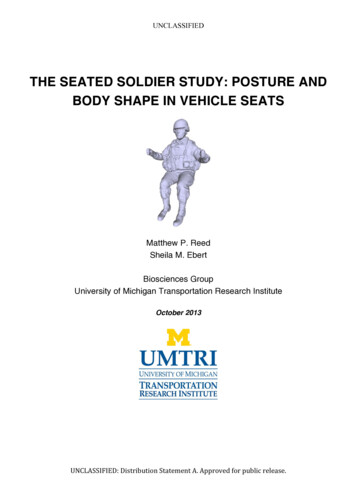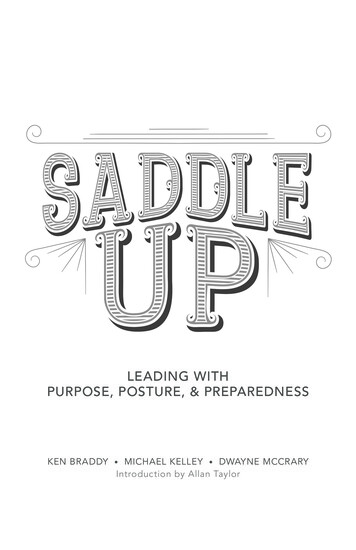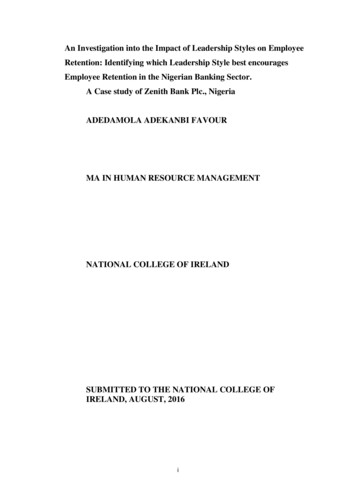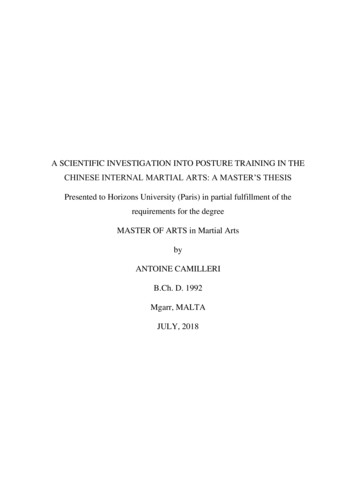
Transcription
A SCIENTIFIC INVESTIGATION INTO POSTURE TRAINING IN THECHINESE INTERNAL MARTIAL ARTS: A MASTER’S THESISPresented to Horizons University (Paris) in partial fulfillment of therequirements for the degreeMASTER OF ARTS in Martial ArtsbyANTOINE CAMILLERIB.Ch. D. 1992Mgarr, MALTAJULY, 2018
iAbstractThe Chinese internal martial arts of Tai Chi Chuan, Hsing Yi Chuan and Pa KuaChang are sister arts philosophically built upon Taoist foundations. They havebeen practiced in mainland China for hundreds of years, building a reputation assuperb health practices and self-defence methods.Although the physical approaches to self-defence and expression of power differ,all three arts devote a major part of training on solo posture work, both static anddynamic, where different postures are performed in a slow, flowing andmeditative manner. Furthermore, all three martial arts lay their foundations on thesame basic principles of standing, which can then be applied into literallyhundreds of shapes or postures making up the backbone of a particular martialart.This thesis sought to investigate scientifically each dissected pillar on which thebasic internal martial art posture is based, in order to explore deeply andunderstand better the potential utility of these internal martial arts. Scientificstudies dealing with human anatomy in the standing position, psychology ofposture, breathing, meditative movement and mindfulness, relaxation and theenergetic biofield, were searched and evaluated for their relevance to posture inthe internal martial arts.The results from the analyzed data reveal a surprising alignment of the principlesof posture training in the Chinese internal arts to emerging scientific discoverieson health and human potential. This has profound implications for modernsociety’s evidence-based health practices, whether preventive, palliative or evencurative.An advantage of the Chinese internal martial arts is that they can be readilypracticed in a small floor area, without the need for equipment, and whenever onecan spare even a few minutes in private. In today’s hectic lifestyle, such a practice
iican yield profound health rewards, both physically and psychologically. Otherimplications are the contribution of these arts to the further development ofhuman potential and sports science, especially in psychology, myofascialbiomechanics and biofield energetics, a new and exciting field of study.
iiiAcknowledgementsA heartfelt thank you to Dr. Roberta Grossi, my academic professor and mentorat Horizons University.Sincere thanks also to my dear parents, who encouraged me to begin this journey,and to my lovely wife Audrey who saw to it that I finish it, notwithstanding allthe sacrifices that it entailed. Audrey’s formatting and proof reading skills wereinvaluable for this work. Taking care of a family with a husband who delved intoresearch straight after work made this degree and thesis a labour of love not justfrom me but also from my wife, for different reasons!Last but not least, a big thank you to Mario Borg of Malta, a great practitioner ofthe internal. He is the direct student of Manfred Rottmann, inner door disciple ofthe legendary internal arts master Wang Shu Jin. He introduced me to, and keepssustaining me in this wonderful journey in the Chinese internal martial arts. Iconsider myself truly lucky to have him as my teacher.
ivDedicationI dedicate this work to my two boys, Yan and Gregory, whom I love so much.
vTable of ContentsPageAbstract . .iAcknowledgment . . .iiiDedication . .ivList of TablesTable 1 7Table 2 9Table 3 .13Table 4 . 21Table 5 .43Table 6 . 47Table 7 . 52Introduction . .1The Secrets of Standing Still .2Literary Contributions in English made to the Internal Martial arts .3Methods .6The Components of an Internal Martial arts Posture .6Results . 9Breathing . . .10Meditative/ Mindful Movement . 15Anatomy:Musculoskeletal System and Fasciae .25
viThe Anatomy of the Upright Posture in Humans 32The Neck . . 37The Tongue Position . .38Knee Biomechanics .39The Ankle 40Stretching and maximal joint range of motion 41The Psychological Effects of Posture 43Relaxation and Physical Performance .48The Biofield . 53Discussion . . .61Breathing .61Meditation/Mindfulness 63Anatomy;The Musculoskeletal System and the Myofascial System . 67The Fascial Bodysuit . 68Head Posture . 70The Tongue Position .70The Knees .71The Ankles .72Power Generation 73Da Mo’s Tendon Changing and Bone Marrow Washing Exercise 75The Internal Martial Arts’ Emphasis on Sinews Development overmuscle . 76
viiThe Psychological effects of Posture . 79Relaxation and Physical Performance .80The Biofield . 82Types of Energy identified within the Biofield .82Biofield receptor biological systems . 85The Relationship between the Biofield of Living Organisms and theEnvironment . .87A Hypothesis on Energy Work in Posture Training . 88Conclusion . .92Recommendations . 94References .95
1IntroductionThe Chinese martial arts of Tai Chi Chuan, Hsing Yi Chuan and Pa Kua Changwere first grouped together as ‘internal’ arts in the literary work by the famousmaster and author Sun Lu Tang in the early twentieth century. They are primarilyTaoist methods of self-defence, health preservation and spiritual cultivation, withan emphasis on energy cultivation or ‘chi gung’ also written as ‘qigong’. Taoisttheories of meditation and energy cultivation are regarded by many as the mainsource from which the hundreds of qigong methods extant today developed(Frantzis, 1998).Recently many scientific studies on the positive health benefits of Tai Chi andqigong have been published, leading to increased attention on, and spread andpopularity of these arts outside China. Virtually no studies have been done onHsing Yi and Pa Kua so far.Although the outer movements of the three martial arts appear to be different, allthese arts have at their core the solo meditative practice of postures while standingstill or moving slowly and mindfully, seeking maximum relaxation, slow quietbreathing, an erect spine and varying degrees of bent knees and particular waysof internal alignments of the myofascial system of the limbs and torso.A major emphasis on feeling the inner body sensations of ‘chi’ or internal energyduring posture training makes the practitioner more and more open andexperienced to benefits and new possibilities that allegedly result from suchtraining (Smith, 2003).This thesis seeks to investigate the multidimensional factors involved in theessence and foundation of the three Chinese internal martial arts; the static anddynamic standing posture training.
2The Secrets of Standing StillZhan zhuang, or post standing, is a method of standing meditation found in allthree martial arts that is still relatively unknown to the general public. It gainedrecognition as a powerful chi cultivation method through the efforts of the famousHsing Yi master Wang Hsiang Chai, who designed this ancient practice aroundhis new creation, Yi Chuan or Da Cheng Chuan in the mid- twentieth century(Yongnian, 2015).A major part of training in this powerful offshoot of Hsing Yi is simply standingstill like a tree, relaxing and feeling one’s internal energy circulating withinoneself as well as without i.e. merging with the energy of the earth and the sky.It is claimed that such an unorthodox training has multiple benefits in internalpower and health (Chuen, 1991). Zhan Zhuang has even been used successfullyin some hospitals in China through the efforts of Wang Hsiang Chai andcontinued by Professor Yu Yongnian (Yongnian, 2015).Orthodox Hsing Yi Chuan makes use of its trademark ‘santi’ posture held forextended periods as a power building technique and the backbone of all otherforms of the art (Frantzis, 1998).Indeed, the prominent Western author Robert Smith wrote how the famous TaiChi master Yang Cheng Fu used to practice by simply holding the ‘Single Whip’and ‘Play the Guitar’ postures for extended periods of time in his later years(Smith, 1990). Practicing the various postures of the Tai Chi form separately asstanding meditation and only later linking them in the signature slow flowingmanner has been described as a Tai Chi Chuan internal secret by another authority(Fai-Wong & Hallander, 1991).Famous internal martial arts master Wang Shu Jin also described Zhan Zhuangas an essential building block of internal martial arts training in his writings(trans. by Howard & Hsiao-Yen, 2009).
3Recently, the real utility of standing posture training, and even the three martialarts as complete systems, has been described as primarily an ingenious methodof energy/chi cultivation and development, even more than for self-defence orhealth benefits (Meredith, 2014). Once the feeling of energy is experienced astangible and real in a static posture, the practitioner begins the dynamic practiceof relaxed but well-aligned, slow sequences of postures pertinent to the three arts,while seeking to maintain the energetic sensations (Meredith, 2014).The hints about the great importance of posture or stance work in the internalmartial arts appear to be hidden in plain sight. ‘Tanren’, or repetitive slow drillingof one or two movements, is highly regarded as a method of power building(Rottmann, 2001). Famous masters of Pa Kua attributed their great power fromendless hours of circle walking while only doing the single palm change (Frantzis,1998).The backbone of Hsing Yi Chuan is the static practice of ‘santi’ posture and theFive Element fists, which are five simple techniques on which the whole art isbuilt. This minimalist approach was emphasized by Wang Hsiang Chai, thecreator of Yi Chuan, who based his art on various standing postures and shortdrills trained repetitively, besides two man sparring and free fighting (Frantzis,1998).Literary contributions in English made to the internal martial artsAfter the introduction of Tai Chi and later the other two internal arts, to the Westin the 1960s, these arts gradually spread throughout America and Europe. Apioneer of Tai Chi Chuan was the famous master Cheng Man Ching, whoseliterary works translated in English helped throw light on the theoretical andphilosophical basis as well as practical pointers on the internal.
4His protégé, Robert W. Smith was also a prolific author who helped disseminateknowledge of these Chinese martial arts. Other highly skilled Western andChinese practitioners who authored books and articles on this subject followedsuit; Bruce K. Frantzis, Manfred Rottmann, Ellis Amdur, Yang Jwing-Ming,Peter Ralston, Mantak Chia, Scott Meredith, Serge Augier and Jonathan Bluesteinamong others.Their collective contributions helped throw light on the Chinese internal martialarts with their trademark Taoist theories and culture and make them moreunderstandable to the Western mind. Pertinent to the subject of ‘chi’ and thephilosophical basis of these martial arts, there have been classical writings byother Chinese masters and historians, some of which have been translated intoEnglish. Frequently their material has been described as ‘archaic’ and vague,however this may be the fruit of sincere attempts by experienced practitioners tocommunicate their pearls of knowledge of material that is so alien to commonpeople as to make the task very difficult.The language that does justice to the energy work and physiology of the internalarts may have been non-existent. Even in the modern age, this has proven to betough, and the best language to do so may be modern science. Yet again, it hasbeen pointed out that once a modern practitioner becomes personally experiencedwith the energy work, the classical writings of the old masters may prove to bevery accurate and suddenly make a lot of sense (Meredith, 2018).‘Chi’ has been described using various terminologies, like ‘bioelectricity’ (Chia& Li, 1996), ‘internal energy’, ‘internal power’ or ‘subtle life force’ (Frantzis,1998) and ‘feeling awareness’ (Ralston, 1989). The physical medium throughwhich this ‘life force’ flows as held by internal martial art theory has beentargeted as the connective tissues or fascia which generates bioelectricity duringmotion (Chia & Li, 1996).
5The importance of the myofascial chains and trains that permeate the human bodyin the transfer of forces within the martial context has been described by Bluestein(2014). A detailed exposition of the inner mechanics used by Chinese internalarts in power generation has been described (Rottmann, 2001).In an excellent article Ellis Amdur sought to highlight the neuroplastic changesbrought about by ‘standing still’ or repetitive drills called ‘tanren’, thus revealinga possible mechanism that makes this type of training so effective (Amdur, 2015).The usefulness of relaxing, opening the joints, aligning to gravity, calming thespirit and mental visualization of the ‘feeling awareness’, in correct internaltraining has been explained in Western terminology (Ralston, 1989).This work seeks to study and dissect the essential components inherent in posturetraining common to all three main internal arts, and investigate them separatelyby searching for and studying scientific papers done on each component. Thisscientific investigation would hopefully shed new insight and knowledge relevantto the subject. This evidence-based material derived from an ancient Chinesesystem should have great potential and utility for modern man.
6MethodsThe Components of an internal martial art postureInternal master Kuo Feng-Chih was very clear in his advice to his student RobertW.Smith (Smith, 2003). He explained that in training all the three arts requirerelaxation, slowness and evenness in action and breathing. Mind is paramount,while the ‘chi’ should be felt to permeate the whole body so that one is graduallyremade and forged into naturalness (Smith, 2003). All three martial artsemphasize an internal spiraling or coiling involving the whole body subtly ormore obviously, while ‘cross linking’ between all parts of the body ensures thatany motion occurs with the whole body moving as one coordinated unit(Rottmann, 2001).The spine is made flexible and strong, without any leaning but kept erect with thehead held up as if suspended by a string. Breathing should be from the nose,natural and abdominal, while the knees are always bent to varying degrees whilekeeping the lumbar and cervical curvatures of the spine reduced. The tip of thetongue touches the hard palate and the chest is kept relaxed and down, not puffedup (Smith, 2003).In accordance with the above guidelines, a preliminary search from GoogleScholar, ResearchGate, PubMed, Medline, SportDiscus and Proquest were madeusing such words and phrases as Tai Chi/Tai Ji, Hsing Yi/Hsing I, Pa Kua/BaGua, Chi Kung/Qigong, ‘chi’/‘qi’, life force, bioenergy, biolectricity, posture,scientific approach/studies/ research, on internal martial arts, meditation, stancework, breathing, standing meditation, anatomy and fascia.It was soon evident that there are hundreds of scientific studies on Tai Chi andQigong health benefits, but a paucity of material on the other two martial arts.Also the subject of ‘chi’ is still not well-addressed in the scientific journals, asopposed to the recently coined term ‘biofield’.
7Sieving through hundreds of other scientific works over a span of eight monthswhile keeping the subject of internal martial arts posture training in mind, itbecame clear that the most productive and relevant searches needed to be for thefollowing:* Breathing* Meditative movement and mindfulness* Anatomy of the spine, musculoskeletal system, fascia and the upright posturein humans. This component was further branched into the neck, knee and anklebiomechanics, and stretching and joint movement range* The psychological effects of posture* Relaxation and physical performance* The BiofieldThus were formed the dissected components for the scientific investigation andresearch into posture training:Internal martial art posturebreathingmeditation / anatomy:mindfulness fasciaspinemusculoskeletalsystemtable 1psychology relaxationandperformancebiofield
8Finally another search from the aforementioned databases was carried out usingthe above listed phrases, and the resulting literature was again examined for itsrelevance to the subject. The papers that were deemed within context weregrouped according to one of the six component subject titles. Preference wasgiven to the most recent ones i.e.from the last 8 years up to May, 2018, howevera few older ones were retained when deemed valid and useful.
9ResultsIn total 85 scientific papers were selected and studied for their relevance toposture training in Chinese internal martial arts. These are organized in tabularform for ease of reference when analyzing the results.BreathingCaldwell, C. & Victoria, H.K. (2011). Breathwork in Body Psychotherapy: Towards a more UnifiedTheory and Practice. Body, Movement and Dance in Psychotherapy, 2011, 1-13. Retrieved from doi:10.1080/17432979.2011.574505Fokkema, D.S. (1999). The psychobiology of strained breathing and its cardiovascular implications:A functional system review. Psychophysiology, 36(2), 164-175.Jefferson, Y. (2010). Mouth Breathing: Adverse Effects on Facial Growth, health, academics andbehavior. General Dentistry. January/February 2010, 18-25.Kuchera, M. & Kuchera, W. (1997). General postural considerations. In R. Ward (Ed.), Foundationsfor osteopathic medicine. Baltimore, MD: Williams & Wilkins.Lundberg, J.O. (2008). Nitric Oxide and the Paranasal Sinuses. The Anatomical Record, Nov:291(11): 1479-84.Mattsson, B. & Mattsson, M. (2002). The concept of ‘psychosomatic’ in general practice reflectionson body language and a tentative model for understanding. Scandinavian Journal of Primary HealthCare, 20(3), 135-138.Pelka, M., Kolling, S., Ferrauti, A., Meyer, T., Pfeiffer, M. & Kellmann, M. (2017). Acute effects ofpsychological relaxation techniques between two physical tasks. Journal of Sports Sciences Vol 352017- Issue 3. Retrieved from https://doi.org/10.1080/02640414.2016.1161208Ruth, A. (2015). The Health Benefits of Nose Breathing. Nursing in General Practice. Retrievedfrom http://hdl.handle.net/10147/559021
10Zhang, Z., Wang, B., Wu, H. et al (2017). Effects of slow and regular breathing exercise oncardiopulmonary coupling and blood pressure. Med Biol Eng Comput 2017; 55: 327-341Table 2BreathingRecent research suggests that nose breathing is very beneficial for health. It hasbeen estimated that about one third of people do not breathe correctly enough tosustain optimal health. Although breathing is a natural vital function, stress, asedentary lifestyle, eating processed foods and excessive talking can lead toincorrect breathing habits (Ruth, 2015). Typically these habits lead to overbreathing, such as mouth breathing, shallow upper chest breathing, sighing andnoisy breaths.Jefferson (2010) outlined potential side effects of chronic mouth breathing, whichare poor facial and jaw growth in children, dryness in the mouth leading toincreased risk of tooth decay, gum and throat infections, and increased risk ofexercise-induced asthma.This is because without the nasal passages to filter, warm and humidify theinhaled air, cold and dry air entering the trachea and bronchi (windpipe) causesthick mucus to be secreted. This slows the cleaning action of the cilia in thewindpipe and also reduces the passage of oxygen into the capillaries surroundingthe alveoli where active exchange of gases occurs in the lungs.Nose breathing forces inhaled air to flow around shelf like structures situatedinside the nose called turbinates, and into and out of various hollow cavities calledsinuses, before entering the windpipe and the lungs. This increases resistance toan inhaled breath by about 50% compared to mouth breathing, helping tomaintain elasticity of the lungs and proper function of the diaphragm (Ruth,2015). Also, nose breathing allows the tongue to stay in the ideal position
11touching the upper anterior hard palate, at rest, helping the proper developmentof the dental arches and jaws.Furthermore, nose breathing allows nitric oxide gas produced in the nose andnasal sinuses to be inhaled along with incoming air. Nitric oxide is a strongbronchodilator (opens the diameter of the bronchi and bronchioles) andvasodilator (makes arterial blood vessels widen in diameter so blood can flowfaster). This action helps lower blood pressure and increases the lungs’ capacityto absorb oxygen (Lundberg, 2008).Breathing through the nostrils with a closed mouth prevents hyperventilationbecause it results in a slower breath (Fried’s work cited in Caldwell & Victoria,2011).Another consequence of over breathing such as mouth breathing, is that too muchcarbon dioxide is lost from the lungs. Although carbon dioxide is a waste product,it is also important to maintain the blood ph and is a catalyst for the release ofoxygen from the haemoglobin in red blood cells. So when the carbon dioxidepartial pressure in the blood falls, the bond between oxygen and haemoglobin isstrengthened, resulting in less vital oxygen being released to the cells in tissuesand organs around the body (Ruth, 2015). In fact, in nose breathing 10-20% moreoxygen uptake occurs compared to mouth breathing.In modern body psychotherapy the clinical intervention to help patients becomeaware of correct, diaphragmatic breathing is proven to be useful. This is becausedysfunctional breathing patterns are regarded as a cause as well as a result ofdysfunctional physical and psychological states. When breathing is disordered,anxiety and panic states are prone to happen, affecting cognition like decisionmaking (Caldwell & Victoria, 2011).Posture has been cited as an important factor in correct breathing patterns. Theideal posture includes normal foot arches, vertical alignment of the ankles and a
12horizontal sacral base, so that the centre of gravity is naturally situated around thelower abdomen (Kuchera & Kuchera, 1997). Correct breathing is seen as startingfrom the belly on the inhale, with the action of the diaphragm.The slow deep inhalation results in a three dimensional expansion wave involvingthe length, side to side and back to front dimensions of the torso. Exhalationsimply needs a gentle relaxation of the diaphragm, with minimal work done bysmall postural spinal muscles to maintain the vertical posture (Caldwell &Victoria, 2011).Tension during breathing, especially in the throat and larynx, but also in theribcage muscles, results in strained breathing. This leads to a reduced airflow andcan negatively affect the immune and cardiovascular systems as well as be a causeof sleep apnoea (Fokkema, 1999).Mattsson & Mattsson asserted that correct diaphragmatic breathing massages theinternal organs promoting health, while releasing endorphins, the painkilling andhappiness inducing chemicals produced by the brain, into the bloodstream (2002).Gilbert’s work revealed that smooth and balanced breathing helps focusedattention and good decision making (cited in Caldwell & Victoria, 2011).The capacity of breathing to affect both the physical and the psychological maybe because it is a vital function that can be both voluntarily controlled but also aninvoluntary activity. The diaphragm has both skeletal muscle that is controlled bythe conscious mind, as well as smooth muscle that keeps working withoutconscious control (Caldwell & Victoria, 2011).While unhealthy breathing patterns are acquired over time as a consequence ofphysical and psychological problems, the good thing is that these bad habits canbe ‘unlearned’ and replaced with correct breathing habits.A recent study showed that decreased, slow and regular breathing from 14 breathsper minute to 10 breaths per minute resulted in a reduction of blood pressure, a
13longer pulse transit time and an increased cardiorespiratory coherence, indicatinga shift towards parasympathetic nervous system activity and positive emotionalstates (Zhang et al, 2017).A recent randomized control trial study by Pelka et al investigated the effects ofpsychological relaxation techniques as a method of recovery between two highintensity physical tasks i.e. sprints (2017). Systematic breathing as a method ofrelaxation recovery proved to enhance performances of the athletes orcompetitors.Meditative / Mindful MovementBenson, H., Beary, J.F. & Carol, M.P. (1974). The relaxation response. Psychiatry 1974; 37:37-46Bhasin, M.K., Dusek, J.A. Chang, B.H. et al. (2013). Relaxation response induces temporaltranscriptome changes in energy metabolism, insulin secretion and inflammatory pathways. PLoSOne 2013: 327-341Buric, I., Farias, M., Jong, J., Mee, C. & Brazil, I.A. (2017). What is the Molecular Signature ofMind-Body Interventions? A Systematic Review of Gene Expression Changes Induced byMeditation and Related Practices. Frontiers in Immunology; 8: 670. doi: 10.3389/fimmu.2017.00670Campos, D., Cebolla, A., Quero, S., Breton-Lopez, J., Botella, C., Soler, J., Garcia-Campayo, J.,Demarzo, M., & Banos, R.M. (2016). Meditation and happiness: Mindfulness and self-compassionmay mediate the meditation-happiness relationship. Personality and Individual Differences, 93(2016), 80-85. Retrieved from http://dx.doi.org/10.1016/j.paid.2015.08.040Clark, D., Schumann, F. & Mostofsky, S.H. (2015). Mindful movement and skilled attention.Frontiers in Human Neuroscience, 9:297. doi: 10.3389/fnhum.2015.00297Hospod, V., Aimonetti, J.M., Roll, J.P. & Ribot-Ciscar, E. (2007). Changes in Human MuscleSpindle Sensitivity during a Proprioceptive Attention Task. The Journal of Neuroscience, 2007 May9, 27 (19): 5172-5178. doi: 10.1523/jneurosci.0572-07.2007
14Jain, S., Shapiro, S.L., Swanick, S., Roesch, S.C., Mills, P.J. Bell, I. & Schwartz, G.E.R. (2007). ARandomized Controlled Trial of Mindfulness Meditation Versus Relaxation Training: Effects onDistress, Positive States of Mind, Rumination and Distraction. Ann Behav Med 2007, 33 (1): 11-21Larkey, L., Jahnke, R., Etnier, J. & Gonzalez, J. (2009). Meditative Movement as a Category ofExercise: Implications for Research. Journal of Physical Activity and Health, 2009, 6, 230-238Mehling, W.E., Wrubel, J., Daubenmier, J.J. et al (2011). Body Awareness: a phenomenologicalinquiry into the common ground of mind-body therapies. Philos Ethics Humanit Med 2011; 6:6Ondobaka, S. & Bekkering, H. (2012). Hierarchy of idea-guided action and perception-guidedmovement. Frontiers in Psychology Dec 2012, Volume 3, Article 579. Retrieved from doi:10.3389/fpsyg.2012.00579Robot-Ciscar, E., Rossi-Durand, C. & Roll, J.P. (2000). Increased muscle spindle sensitivity tomovement during reinforcement manoeuvers in relaxed human subjects. Journal of Physiology(London). 523: 271-282.Ruge, D., Liou, L.M. & Hoad, D. (2012, April 25). The Journal of Neuroscience, 32 (17): 57055706. doi: 10.1523/jneurosci.0430-12.2012Tang, Y.Y, Holzel, B.K. & Posner, M.I. (2015). The neuroscience of mindfulness meditation. NatureReviews Neuroscience AOP published online March 15, 2015. doi: 10.1038/nrn3916Wheeler, M.S., Arnkoff, D.B. & Glass, C.R. (2017). The Neuroscience of Mindfulness: HowMindfulness Alters the Brain and Facilitates Emotion Regulation. Mindfulness. doi: 10.1007/s12671017-0742-xWulf, G. & Prinz, W. (2001). Directing attention to movement effects enhances learning: A Review.Psychonomic Bulletin & Review 2001, 8 (4), 648-660Yeung, A., Chan, J.S., Cheung, J.C. & Zou, L. (2017). Qigong and Tai-Chi for Mood Regulation.Focus 2017; 00:1-8. doi: 10.1176/appi.focus.20170042Table 3
15Meditative / Mindful MovementLarkey et al proposed meditative movement as a new category of exercise whichis defined by some method of movement or posture, with a focus on breathingand a calm frame of mind with the aim of achieving a deep state of relaxation(2009). In meditative movement the mind is kept engaged in the movement itselfand in the present moment, to the exclusion of extraneous thoughts. The bodymovements are typically slow, relaxed and flowing, however may range fromdynamic movements to static postures.A deep state of relaxation during meditative movement is also required and anintrinsic ingredient. Two methods described as meditative movements were TaiChi and Qigong (Larkey et al, 2009). This paper outlined the growing evidencesuggesting that these two methods show positive health improvements for bloodpressure, mental health, functional balance and immunity.Bodily movements have long been used as a medium to cultivate mental skillssuch as mindfulness, self-control and attention. Examples of such methods areYoga and Tai Chi (Clark et al, 2015). It has been proposed that mindfulmovement practice could improve attention skills that might transfer to otherforms of mental activity, as suggested by Feldenkrais, and this could have greatbenefit for individuals with ADHD (attention deficit hyperactivity disorder)(Clark et al, 2015).Feldenkrais held that the quality of cognitive control, meaning improvement
Mar 15, 2015 · The Secrets of Standing Still Zhan zhuang, or post standing, is a method of standing meditation found in all three martial arts that is still relatively unknown to the general public. It gained recognition as a powerful
